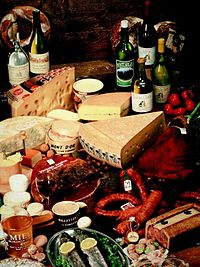Food writing is a genre of writing that focuses on food and includes works by food critics, food journalists, chefs and food historians.

Larousse Gastronomique is an encyclopedia of gastronomy. The majority of the book is about French cuisine, and contains recipes for French dishes and cooking techniques. The first edition included few non-French dishes and ingredients; later editions include many more. The book was originally published by Éditions Larousse in Paris in 1938.

A recipe is a set of instructions that describes how to prepare or make something, especially a dish of prepared food. A sub-recipe or subrecipe is a recipe for an ingredient that will be called for in the instructions for the main recipe.

Lasagna is a type of pasta, possibly one of the oldest types, made of very wide, flat sheets. Either term can also refer to an Italian dish made of stacked layers of lasagna alternating with fillings such as ragù, béchamel sauce, vegetables, cheeses, and seasonings and spices. The dish may be topped with grated cheese, which becomes melted during baking. Typically cooked pasta is assembled with the other ingredients and then baked in an oven. The resulting baked pasta is cut into single-serving square or rectangular portions.
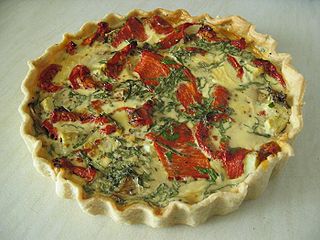
Quiche is a French tart consisting of pastry crust filled with savoury custard and pieces of cheese, meat, seafood or vegetables. A well-known variant is quiche Lorraine, which includes lardons or bacon. Quiche may be served hot, warm or cold.

A cookbook or cookery book is a kitchen reference containing recipes.

Jean Anthelme Brillat-Savarin (French pronunciation:[ʒɑ̃ɑ̃tɛlmbʁijasavaʁɛ̃], was a French lawyer and politician, who, as the author of Physiologie du goût, became celebrated for his culinary reminiscences and reflections on the craft and science of cookery and the art of eating.

Apicius, also known as De re culinaria or De re coquinaria is a collection of Roman cookery recipes, which may have been compiled in the fifth century CE, or possibly earlier. Its language is in many ways closer to Vulgar than to Classical Latin, with later recipes using Vulgar Latin added to earlier recipes using Classical Latin.
Gourmet is a cultural idea associated with the culinary arts of fine food and drink, or haute cuisine, which is characterized by refined, even elaborate preparations and presentations of aesthetically balanced meals of several contrasting, often quite rich courses. Historically the ingredients used in the meal tended to be rare for the region, which could also be impacted by the local state and religious customs. The term and the related characteristics are typically used to describe people with refined tastes and enthusiasm. Gourmet food is frequently provided in more expensive, smaller servings. When it comes to Gourmet, there are also frequently cross-cultural interactions that introduce new ingredients, materials, and traditions.
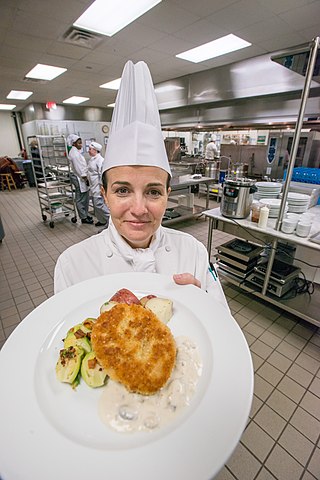
Culinary arts are the cuisine arts of food preparation, cooking, and presentation of food, usually in the form of meals. People working in this field – especially in establishments such as restaurants – are commonly called chefs or cooks, although, at its most general, the terms culinary artist and culinarian are also used. Table manners are sometimes referred to as a culinary art.
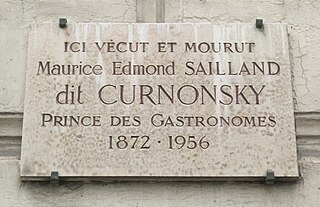
Maurice Edmond Sailland, better known by his pen-name Curnonsky, and dubbed the Prince of Gastronomy, was one of the most celebrated writers on gastronomy in France in the 20th century. He wrote or ghost-wrote many books in diverse genres and many newspaper columns. He is often considered the inventor of gastronomic motor-tourism as popularized by Michelin, though he himself could not drive. He was a student of Henri-Paul Pellaprat.

Marcel Rouff was a Swiss novelist, playwright, poet, journalist, historian, and gastronomic writer. With Curnonsky he wrote the multi-volume work La France gastronomique, guide des merveilles culinaires et des bonnes auberges françaises. He may be best known today for his novel about the fictional gourmet Dodin-Bouffant, La vie et la passion de Dodin-Bouffant, Gourmet, which was first published in 1924 and dedicated to his friend Curnonsky and the great nineteenth-century French gastronome Jean-Anthelme Brillat-Savarin. Rouff's novel was adapted for French television in 1973 by Jean Ferniot.

Marcus Gavius Apicius is believed to have been a Roman gourmet and lover of luxury, who lived sometime in the 1st century AD, during the reign of Tiberius. The Roman cookbook Apicius is often attributed to him, though it is impossible to prove the connection. He was the subject of On the Luxury of Apicius, a famous work, now lost, by the Greek grammarian Apion. M. Gavius Apicius apparently owed his cognomen to an earlier Apicius, who lived around 90 BC, whose family name it may have been: if this is true, Apicius had come to mean "gourmand" as a result of the fame of this earlier lover of luxury.

A dish in gastronomy is a specific food preparation, a "distinct article or variety of food", ready to eat or to be served.
Martino de Rossi, was an Italian 15th-century culinary expert who was unequalled in his field at the time and could be considered the Western world's first celebrity chef. He made his career in Italy and was the chef at the Roman palazzo of the papal chamberlain ("camerlengo"), the Patriarch of Aquileia. Martino was applauded by his peers, earning him the epitaph of the prince of cooks. His book Libro de Arte Coquinaria is considered a landmark in Italian gastronomic literature and a historical record of the transition from medieval to Renaissance cuisine.

Alexandre-(Balthazard)-Laurent Grimod de La Reynière was a lawyer by qualification who acquired fame during the reign of Napoleon for his sensual and public gastronomic lifestyle. Son of Laurent Grimod de La Reynière, he inherited the family fortune on the death of his father, a fermier général, in 1793. He was a member of the Société du Caveau.

Fuchsia Charlotte Dunlop is an English writer and cook who specialises in Chinese cuisine, especially Sichuan cuisine. She is the author of seven books, including the autobiographical Shark's Fin and Sichuan Pepper (2008). According to Julia Moskin in The New York Times, Dunlop "has done more to explain real Chinese cooking to non-Chinese cooks than anyone".

Lyonnaise cuisine refers to cooking traditions and practices centering on the area around the French city of Lyon and historical Lyonnais culinary traditions.
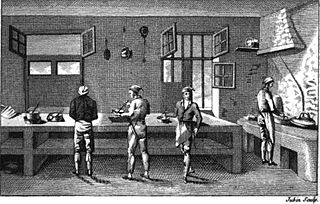
Antoine B. Beauvilliers was a French restaurateur who opened the first grand restaurant in Paris and wrote the cookbook L'Art du Cuisinier. Jean Anthelme Brillat-Savarin considers him the most important of the early restaurateurs, as "he was the first to have an elegant dining room, handsome well-trained waiters, a fine cellar and a superior kitchen." Beauvilliers is described as a "portly figure, his triple chin, his broad, joyous face, and the light that sparkles in his large grey eye." He dressed fashionably and carried a sword. His success was enhanced by his ability to "cater to and flatter rich patrons", attending to them personally and helping them with items on the menu; he had a prodigious memory and could recall a patron he had not seen in 20 years.

Florentine or à la Florentine is a term from classic French cuisine that refers to dishes that typically include a base of cooked spinach, a protein component and Mornay sauce. Chicken Florentine is the most popular version. Because Mornay sauce is a derivation of béchamel sauce which includes roux and requires time and skill to prepare correctly, many contemporary recipes use simpler cream based sauces.
